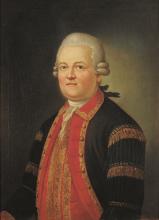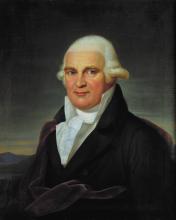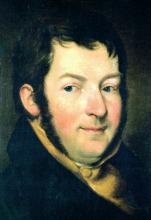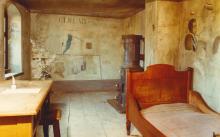A historical outline
The Freiberg Mining Academy was founded on 21 November 1765. Its establishment can be seen as a measure by the Saxon government to boost the economy after the "Augustan Age" and the Seven Years' War (1756-63) by increasing the utilisation of domestic raw materials in order to overcome the high national debt at the same time. Training and research at the new institution was and still is characterised by the close link between theory and practice. The institution soon gained a reputation as one of the world's leading mining science teaching and research centres. Established in 1765, the Bergakademie is now regarded as the oldest mining science university in the world. Following its example, numerous other mining academies were founded, e.g. in St. Petersburg, Russia (1773), Almadén, Spain (1777) and Mexico (1792). It was and is home to scientists who have influenced the development of mining science and technology worldwide. The two elements germanium and indium were discovered here. Since its foundation, TU Bergakademie Freiberg has attracted students from all over the world, including Alexander von Humboldt and the discoverers of other chemical elements, such as Fausto and Juan José d'Elhuyar (tungsten) and Manuel Andrés del Río (vanadium).

Founding in times of need - von Heynitz and von Oppel
Friedrich Anton von Heynitz, Saxon Mining Commissioner General and member of the State Economic, Manufactory and Commerce Deputation, together with Freiberger Oberberghauptmann Friedrich Wilhelm von Oppel submitted a proposal on 15 November 1765. On 15 November 1765, he proposed to Prince Regent Xaver, who was in Freiberg, that a fund financed from state funds be made available for the establishment of a geometric drawing school and a metallurgical and chemical school in Freiberg. For Saxony, which had been economically devastated as a result of the Seven Years' War, a reforming measure was planned to raise the level of education of the civil servants entrusted with specific tasks. The proposal therefore fitted in well with the Restoration Commission's reform concept. Just six months later, lectures could begin and the "Berg Academy" was born.
Founding in times of need - von Heynitz and von Oppel

Friedrich Anton von Heynitz, Saxon Mining Commissioner General and member of the State Economic, Manufactory and Commerce Deputation, together with Freiberger Oberberghauptmann Friedrich Wilhelm von Oppel submitted a proposal on 15 November 1765. On 15 November 1765, he proposed to Prince Regent Xaver, who was in Freiberg, that a fund financed from state funds be made available for the establishment of a geometric drawing school and a metallurgical and chemical school in Freiberg. For Saxony, which had been economically devastated as a result of the Seven Years' War, a reforming measure was planned to raise the level of education of the civil servants entrusted with specific tasks. The proposal therefore fitted in well with the Restoration Commission's reform concept. Just six months later, lectures could begin and the "Berg Academy" was born.

Abraham Gottlob Werner - founder of geognosy
Abraham Gottlob Werner (1749-1817), the most important scholar at the Bergakademie in its early days, brought order to the world of minerals and rock strata. He was appointed as a teacher at the Bergakademie in 1775. Werner is regarded as the founder of geognosy, the study of the structure and construction of the earth's solid crust, which can be described as the forerunner of geology. He laid the foundations on which mineralogy and geology could develop as independent sciences.
Exactly 250 years ago, Werner published a groundbreaking work that still has an impact today. In 1774, a book on mineral identification was published with the full title Von den Äußerlichen Kennzeichen der Fossilien. To this day, researchers use very similar catalogues of the sensually perceptible properties of minerals,
Werner's theory of mineralogical characteristics is 250 years old
Werner attracted such important personalities as Alexander von Humboldt, Franz Xaver von Baader, Leopold von Buch, Friederich Mohs and Robert Jameson . Under the influence of his students, a scientific society was founded in England in 1808, the Wernerian Natural History Society, whose members dedicated themselves to a broad spectrum of scientific research, including mineralogy, botany and entomology.
Under Werner, the Bergakademie Freiberg developed into an internationally esteemed and recognised mining science centre with worldwide appeal.
The Mineralogische Sammlung im Werner-Bau is closely associated with the name Abraham-Gottlob-Werner.
Abraham Gottlob Werner - founder of geognosy

Abraham Gottlob Werner (1749-1817), the most important scholar at the Bergakademie in its early days, brought order to the world of minerals and rock strata. He was appointed as a teacher at the Bergakademie in 1775. Werner is regarded as the founder of geognosy, the study of the structure and construction of the earth's solid crust, which can be described as the forerunner of geology. He laid the foundations on which mineralogy and geology could develop as independent sciences.
Exactly 250 years ago, Werner published a groundbreaking work that still has an impact today. In 1774, a book on mineral identification was published with the full title Von den Äußerlichen Kennzeichen der Fossilien. To this day, researchers use very similar catalogues of the sensually perceptible properties of minerals,
Werner's theory of mineralogical characteristics is 250 years old
Werner attracted such important personalities as Alexander von Humboldt, Franz Xaver von Baader, Leopold von Buch, Friederich Mohs and Robert Jameson . Under the influence of his students, a scientific society was founded in England in 1808, the Wernerian Natural History Society, whose members dedicated themselves to a broad spectrum of scientific research, including mineralogy, botany and entomology.
Under Werner, the Bergakademie Freiberg developed into an internationally esteemed and recognised mining science centre with worldwide appeal.
The Mineralogische Sammlung im Werner-Bau is closely associated with the name Abraham-Gottlob-Werner.

Brilliant scientific achievements
With August Wilhelm Lampadius (1772-1842), the people of Freiberg saw the light. The professor was the first on the European continent to install a gas lantern on his house in Fischergasse in Freiberg and developed the principle of gas lighting to such an extent that it could be used for the first time in an industrial plant. In order to promote practical teaching, Lampadius set up a chemical-metallurgical university laboratory at the Bergakademie in 1796/97.
In 1886, Clemens Alexander Winkler (1838-1904) isolated the chemical element germanium when a difference repeatedly occurred in the chemical analysis of a mineral, thus confirming the periodic table of elements developed by Dmitri Mendeleev (1834-1907), who had predicted an element with the properties of germanium in his list with "ekasilicon". The chemist Hieronymus Theodor Richter (1824-1898) and the physicist Ferdinand Reich (1799-1882) had already discovered the metal indium in 1863. It was given its somewhat misleading name because of its characteristic indigo blue spectral line.
The Winkler Collection contains around 1,400 inorganic chemical preparations, most of which were synthesised in the second half of the 19th century. The collection goes back to Clemens Alexander Winkler, who produced most of the samples himself at the Bergakademie. The original of the rare mineral argyrodite, from which Winkler isolated germanium in 1886, can also be found here. The collection was enriched by gifts such as the gallium sample from its discoverer Lecoq de Boisbaudran (1838-1912).
Chemical elements were also discovered by former students of the Bergakademie, such as tungsten (1783) by the brothers Juan José (1754-1796) and Fausto d'Elhuyar (1755-1833) and vanadium (1801) by Andrés Manuel del Río (1764-1849).
Brilliant scientific achievements

With August Wilhelm Lampadius (1772-1842), the people of Freiberg saw the light. The professor was the first on the European continent to install a gas lantern on his house in Fischergasse in Freiberg and developed the principle of gas lighting to such an extent that it could be used for the first time in an industrial plant. In order to promote practical teaching, Lampadius set up a chemical-metallurgical university laboratory at the Bergakademie in 1796/97.
In 1886, Clemens Alexander Winkler (1838-1904) isolated the chemical element germanium when a difference repeatedly occurred in the chemical analysis of a mineral, thus confirming the periodic table of elements developed by Dmitri Mendeleev (1834-1907), who had predicted an element with the properties of germanium in his list with "ekasilicon". The chemist Hieronymus Theodor Richter (1824-1898) and the physicist Ferdinand Reich (1799-1882) had already discovered the metal indium in 1863. It was given its somewhat misleading name because of its characteristic indigo blue spectral line.
The Winkler Collection contains around 1,400 inorganic chemical preparations, most of which were synthesised in the second half of the 19th century. The collection goes back to Clemens Alexander Winkler, who produced most of the samples himself at the Bergakademie. The original of the rare mineral argyrodite, from which Winkler isolated germanium in 1886, can also be found here. The collection was enriched by gifts such as the gallium sample from its discoverer Lecoq de Boisbaudran (1838-1912).
Chemical elements were also discovered by former students of the Bergakademie, such as tungsten (1783) by the brothers Juan José (1754-1796) and Fausto d'Elhuyar (1755-1833) and vanadium (1801) by Andrés Manuel del Río (1764-1849).
Deeper insights - Friedrich von Hardenberg (Novalis)
The Romantic poet Georg Philipp Friedrich von Hardenberg (1772-1801) - his pen name Novalis means "the tiller of new ground" - first used this pseudonym for his literary writings in Freiberg in 1798. He studied in Freiberg from the end of 1797 to May 1799. Under the influence of lectures, excursions and underground shifts, he created works such as "Blüthenstaub" and "Hymnen an die Nacht".
He took many impulses from the mining industry to incorporate them into his artistic creations. Profound thoughts about the formation and interior of the earth are combined with insights into the nature of man, history and society. Chapter 5 of the novel fragment "Heinrich von Ofterdingen" gives an unrivalled and unsurpassed picture of mining itself, indeed of the myth of mining.
Although not as students at the mining academy, but also for study purposes, the poet and natural scientist Mikhail Vasilyevich Lomonosov, the Russian Tsar Peter I, Johann Wolfgang von Goethe...

The carcass - living history
One of the more curious facts about the history of the Freiberg Mining Academy is the dungeon, which was in use from 1851-1872 and can still be visited today. In the historic detention room, students were imprisoned here, for example, for not handing in books or receipts, and later for more serious offences such as insulting teachers or fellow students or arguments with Freiberg night watchmen. The longest punishment recorded in the dungeon book was 14 days. In the 20 years of its existence, however, only 48 students were punished with detention.
The historical detention room for students at the Bergakademie is the only surviving detention room at a German technical college or technical university. It was used around the middle of the 19th century and documents everyday student life at the time with its numerous murals and inscriptions.
The carcass - living history

One of the more curious facts about the history of the Freiberg Mining Academy is the dungeon, which was in use from 1851-1872 and can still be visited today. In the historic detention room, students were imprisoned here, for example, for not handing in books or receipts, and later for more serious offences such as insulting teachers or fellow students or arguments with Freiberg night watchmen. The longest punishment recorded in the dungeon book was 14 days. In the 20 years of its existence, however, only 48 students were punished with detention.
The historical detention room for students at the Bergakademie is the only surviving detention room at a German technical college or technical university. It was used around the middle of the 19th century and documents everyday student life at the time with its numerous murals and inscriptions.
Between 1945 and 1990
Teaching and research activities were quickly resumed at the Freiberg Mining Academy for the development of the raw materials industry in the period after the Second World War from 1945. The university underwent a significant expansion of its spatial capacities. This was accompanied by an increase in the number of staff and an expansion of research and teaching capacities. The range of courses on offer changed due to the establishment of new degree programmes. At the same time, the composition of the student body changed. The proportion of women rose sharply. The Bergakademie was opened up to "workers' and farmers' children" through a socially determined allocation of study places and the establishment of the Pre-Study Institute, known as the Workers' and Farmers' Faculty (ABF) from 1949.
On the threshold of the 21st century
After the Bergakademie Freiberg was integrated into the West German higher education system, it quickly succeeded in positioning itself in the German higher education landscape as a whole on the basis of its unique research and teaching profile. Bergakademie Freiberg was the first East German university to become a member of the German Research Foundation (DFG). From 1993, it was able to operate under the name "Technical University" .
At all Saxon universities, the teaching staff was reorganised after 1990. All professors lost their jobs, so to speak, and new chairs were created and advertised. As a result, 50% of the professorships were filled by former professors, 25% by former lecturers and senior assistants and 25% by other experts from Germany or abroad. Following the closure of the economics and social sciences sections, a new economics faculty with 15 professorships was established in the 1990s due to the importance of economics in the educational profile of the Bergakademie.
Rising student numbers
Student numbers fell sharply in the early 1990s. In 1993, there were fewer than 2,000 students. However, extensive student recruitment, the special range of courses on offer in Freiberg with new, contemporary degree programmes such as Geoecology, Environmental Engineering and Applied Natural Sciences as well as good job prospects for most degree programmes led to a rapid recovery in student numbers. Today, more than 4,000 students from all over the world study here.
Profile university
Today's university is a profile university. The research and study profile of TU Bergakademie Freiberg is characterised by the scientific fields of GEO, MATERIALS, ENERGY, ENVIRONMENT and ECONOMICS. The university is a leader in third-party funding and occupies a top position in terms of third-party funding per professor in Germany as a whole.
Studies Research University in figures